Software frames the premise of numerous cutting-edge gadgets, such as personal computers, smartphones, tablets, the Internet of Things, and network systems, on which we depend so heavily in our daily lives.
While the consumer software industry is a multi-billion-dollar industry, B2B software has created modern market giants in several industries. There are thousands of commercial off-the-shelf software programs available to cater to the service needs, yet businesses usually prefer custom software development. Concurrently, software development companies worldwide are geared to match the all-time high software demand, especially mobile apps for Gen Z and automation tools for changing world businesses.
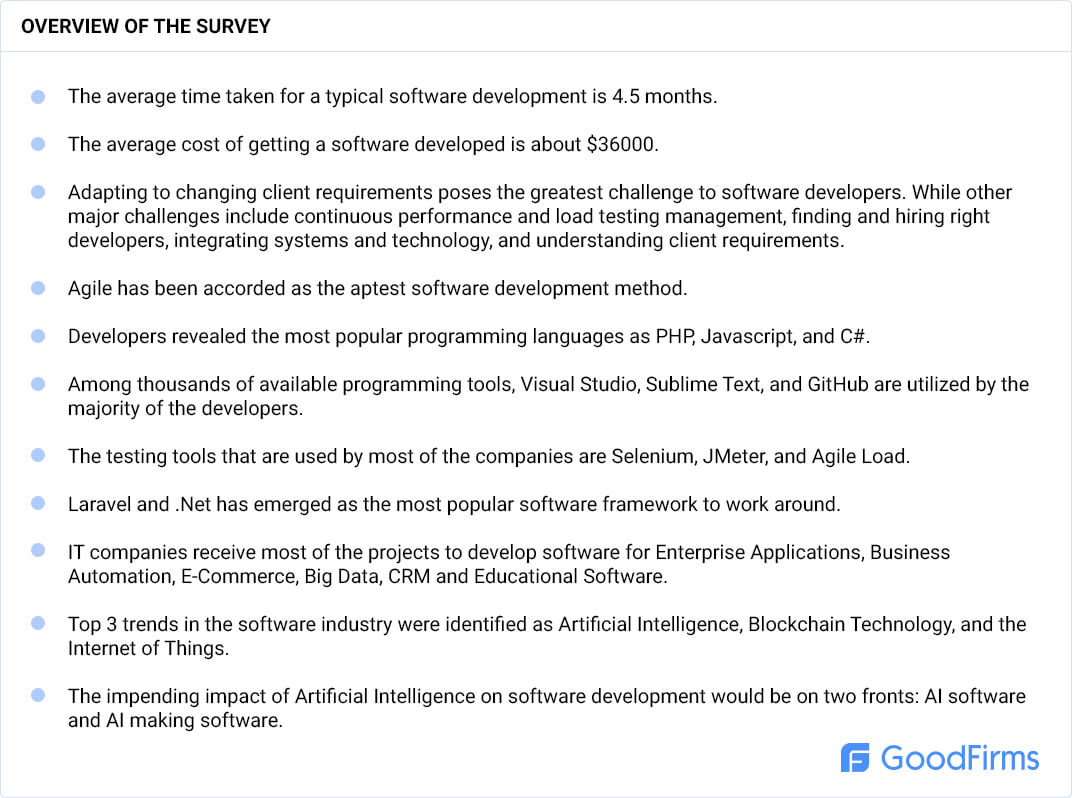
The Detailed Software Development Statistics
At a fundamental level, software development is writing and maintaining the source code. While a broader scope includes stages from idea generation to final product manifestation, which forms the current institution of software development. This raises requirements for sophisticated models and tools. While the industry faces problems, several methodologies have been developed over time to enable effective and efficient software development.
The survey discovered the best insights, such as time, cost, challenges, methods, languages, tools employed, popular frameworks, software projects in demand, popular tech trends, and development automation to update developers with the latest market happenings. Here is the detailed research by GoodFirms with bona fide statistics:
1. What is the average time to develop and deliver custom software?
Generally, typical software development activities include identification of needs, planning, designing, development, testing, and deployment. An intriguing fact emerged when the participant companies responded with a range of periods they usually take to tailor software. Interestingly, many companies offer regular software maintenance and support to their clients for a long time.
Depending on the type, requirement, and technology used for the project, each project takes a range of periods from one to nine months. Whereas most of the surveyed firms are attuned to deliver custom software in an average time period of 4.5 months. Below are the unique facts mined from the survey data:

- 7.70% of the developers can deliver a typical software with basic features in less than 2 months.
- 38.50%, a larger chunk, of the agencies deliver software in a time period of 2 - 4 months.
- 61.60% of the development companies established a standard average development time period of 4 - 6 months.
- 10.81% of the software firms deliver fine software with maintenance and support, in a time span of more than 6 months.
2. How much does a typical software development cost?
The price range, from the received information, for software development projects ranged from $3000 to $120,000. Also, survey contributors retorted that the general pricing for project proposals varies on key factors like base technology and integrated features, along with several underlying factors such as resources engaged, quality of code, scope, duration of a project, experience, and brand recognition.
Considering the vast factors affecting the pricing, the average cost of developing custom software, with basic features and offering a median utility, comes around $36000. Also, a few companies provide extended support, maintenance, and even timely upgrades for a fee. The figures obtained from the companies are as follows:
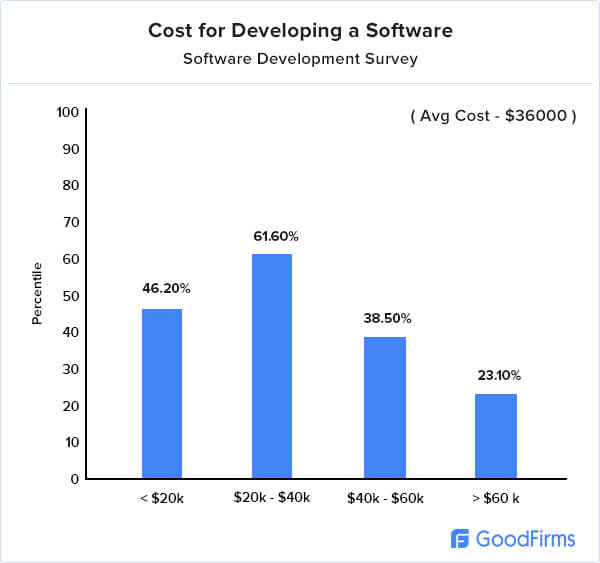
- 46.20% of the development firms proclaimed that they offer a basic software development at a price under $20,000 mark.
- 61.60% - a majority of companies offer software projects of general utility at a price range of $20,000 to $40,000.
- 38.50% of IT firms charge around $40,000 - $60,000 for a sophisticated software project.
- Lastly, 23.10% of the participant companies cater to software development at a price over $60,000.
3. What are the major challenges faced by software development companies?
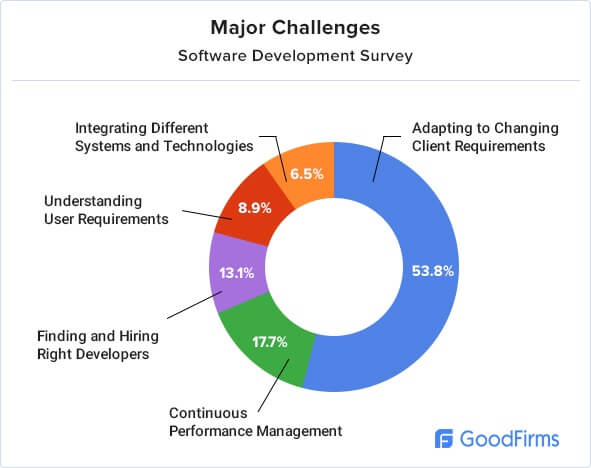
Adjusting to the changing trends and demands of the market, clients often revise the software features and requirements in the wake of new ideas. 53.80% of the participant companies concurred that adapting and meeting these changing client requirements poses the biggest challenge for the developer team. This scope creep leads to the project’s feature creep, which requires a new development or redevelopment. This delays the scheduled milestones and incurs budget overruns.
Furthermore, around 17.70% of the respondent companies expressed that continuous performance and load testing management is one of the major challenges faced by the development team. While continuous performance management is imperative for flawless software, strategies and operations pose a major challenge to coping with and maintaining.
Every software project is unique and demands an equally unique set of tools, technology, and skills. Thus, another 13.10% of IT companies find it challenging to build a suitable team for an incoming client project. Industry leaders tend to take a considerable time period and dynamic filtrations to build a solid team, which they can proclaim for any project needs. But before that, finding and hiring the right developers who comprehend the project is a test.
About 8.90% of the companies face challenges related to perceiving client requirements. These participants relayed that sometimes clients aren’t sure enough about their requirements, or rarely, a cultural or geographical difference becomes a roadblock in comprehending certain stipulations.
Integrating different systems and technologies offers plenty of challenges for a few more, almost 6.50% of the surveyed developer companies. While businesses choose to develop a custom software as it offers flexibility in terms of integration; it remains one of the most complex tasks to integrate a wide range of business systems and technologies like accounting, CRM, website, workflow management, inventory management among many others.
4. What are the top Software Development Methodologies employed by software companies?
Typically, if determined rationally, an apt approach to software development could enhance the software at several phases of development with limited resources and economic budget. During the brief history of software, around six decades, a few dozen development models have been realized, efficiently adapted, and evolved into successors.
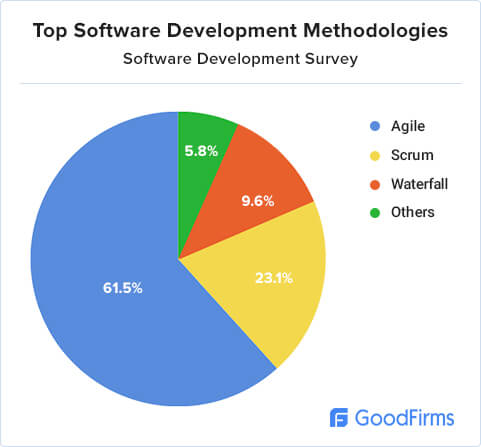
The most recent innovation in the sector is, plausibly, Agile Software Development, which garners a wide implementation from 61.50% of the surveyed companies. The model typically employs increments, iterations, and evolutions. While interacting with the participants, the reasons for such conviction were clear -
- Efficient team collaboration - to bring flexibility in engagement.
- Regular client involvement - encouraging transparency in the development phase and evolution of solutions.
- Suitable for adapting to changing client requirements, which poses one of the biggest challenges for developer teams.
Scrum - an Agile-adapted framework - enhances association and better client involvement. A considerable chunk of software firms, around 23.10%, use Scrum or the adapted versions for the following reasons:
- Enhanced team collaborations - with daily scrum meetings and software continuous integration.
- Viable client involvement - with Scrum masters keeping them in the loop with updates and documentation.
- Best results - providing client satisfaction and performance-optimized solutions.
The most primitive on the list, Waterfall, is still considered by a few, 9.60% to be precise, project leaders. According to participant firms, they practice Waterfall for certain areas of engineering design and development as it provides rapid progress with a linear and sequential approach.
Other 5.80% of developer companies approach development by combining several well-developed methods to achieve maximum outcomes and reinforced services. These types of approaches inspire the next generation of Software Development Processes.
5. Which programming languages do most developers prefer?
With changing Software demands, Programming Languages can develop, ascend to acclaim, and then fade away over the span of a couple of years. At GoodFirms, we perceive five vogue languages of our times - Java, PHP, Python, JavaScript, and C#. When enquired about the preferences, developers indicated the following statistics:

- With a majority of 77%, developers have audibly declared their first preference for PHP.
- Much celebrated, 69.30% of the computer programmers still prefer frameworks written in high-level JavaScript.
- 53.90%, considerably favored, of the developers asserted that C# is being employed for software development.
- With the limited demand, just 41.30% of developers employ Java for certain software projects.
- While 35.70% of the agencies still prefer to use the oldest programming languages on the list - Python.
- Moreover, 11.40% of the developers use other languages.
With a little over three-quarters of a percentile, PHP - a general-purpose server-side scripting language - helms most software development projects. Top PHP development companies connect this popularity with the versatile applications of the language. JavaScript is employed by top JavaScript developers due to its preference for a high-level, dynamic, and interpreted programming language.
Comprehending the surging preferences of these two web-scripting languages for software development, GoodFirms research infers the current trend of software online integration.
While traditional neat languages, like C#, Java, and Python, are still widely used for software and mobile app development, their utility has waned gradually. The reasonable argument is that the trendy technologies entail much more than just a desktop application.
6. What are the most widely used programming and testing tools?
Various development tools offer support and supplementary functionality, of variable scope and scale, to programming languages. Choosing a software development tool is analogous to choosing a hardware tool; one has to consider flexibility as well as the constraints of the project.
When surveyed, the developers revealed a range of tools they use in typical software development. With the availability and popularity of multitudinous tools, we scrutinized every tool and labeled them either a Programming Tool or a Testing Tool. The software developer statistics are as follows:
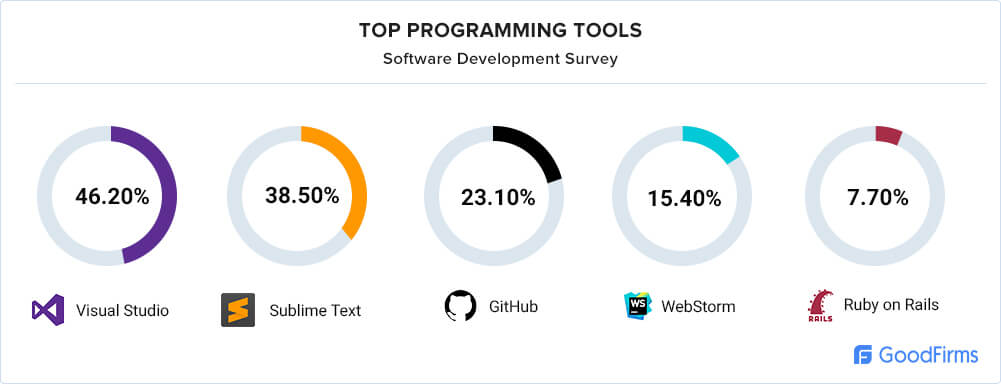
- About 46.20% of the participant developers utilize Microsoft’s Visual Studio for their projects.
- Meanwhile, 38.50% of programmers code and assemble software using Sublime Text.
- About 23.10% of the participants say they employ GitHub for web-hosting software development.
- More than 15.40% of developers employ WebStorm, and about 7.70% develop on Ruby on Rails.
- While these are just five of the total thirteen tools mentioned by participants out of an ocean of available tools online, here are some of the honorary mentions (69.30% of them): NodeJS, Bitbucket, Jenkins, NetBeans, PhpStorm, Postman, and Docker, among a few thousand others.
The huge popularity of tools such as Visual Studio, Sublime Text, WebStorm, and Ruby on Rails implies developers’ tendency to practice an Integrated Development Environment rather than a variety of discrete tools.
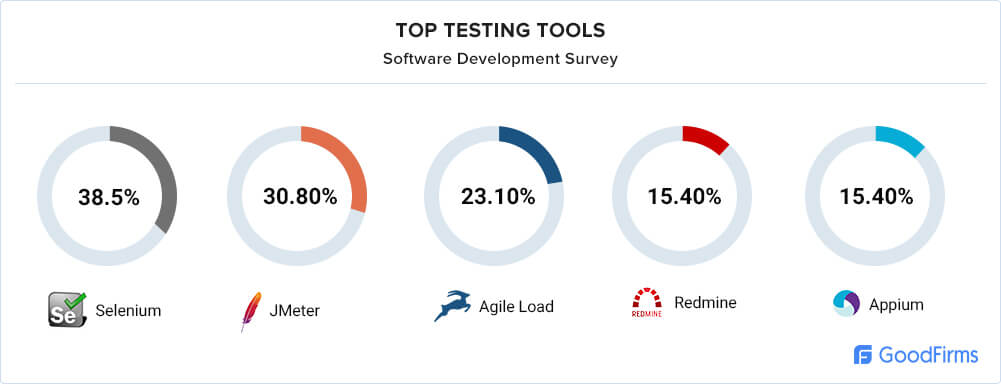
- Popularly, Selenium - a software-testing framework - is employed by a majority, i.e, 38.50% of the testers, given the generic adaptability and flexibility of the tool.
- Apache JMeter is popular among 30.80% of the participants for load and performance testing.
- Also, 23.10% of the surveyed firms employ Agile Load to optimize and automate the testing process.
- Each of Redmine and Appium engages 15.40% of programmers for testing practices.
- With honorary mentions (Others; Which combine 46.2% of developers) of Jira, TestLink, Nmap, IronWASP, BrowserStack, and Gatling, there are hundreds of testing tools available in the market.
At various stages and platforms, developers have implied the importance of automated and continuous performance testing. This is reflected in the current popularity of tools like Selenium, Agile Load, and Appium.
7. Top Frameworks For Software Development:
Frameworks are aimed at a one-size-fits-all solution for developers, so that programmers and designers can focus their time and efforts on fulfilling client software requirements instead of developing a basic and tedious working framework. For GoodFirms’ software development research, we discussed with the participant firms regarding the comprehensive usefulness and adaptive convenience of some of the most common software frameworks viz. .NET, CakePHP, Ruby on Rails, CodeIgniter, Laravel, and Django. When queried about the utility and general suitability, two out of the seven frameworks emerged as the most popular, employed by more than half of the survey takers. The following are the software development statistics:

- Laravel has been declared as the most popular by the developers with a staggering approval of 61.60%.
- Coming a long way, .Net has a rich history and is currently popular with designers and programmers at 53.90%.
- Among the top runner-up frameworks are Ruby on Rails (30.80%) and CodeIgniter (23.10%).
- Developers also employ frameworks like CakePHP (15.40%), Django (9.50%), and React (7.40%).
MIT-licensed Laravel is one of the most articulated frameworks and even has dedicated Laravel development companies for easy software development. One of the most modern frameworks, it employs the best practices of the latest PHP and is handy to developers for building any kind of web application.
While .Net has been the oldest and has multiplied its applicability with growing variety of digital products like cutting-edge software, mobile applications, websites, and E-commerce among dozen others. According to top .Net developers, this versatility and discreet revamping have been the main reasons for its sustained popularity for years.
8. Generally, what kind of software projects do IT companies receive?
According to a certain theory of the expansion of the software industry, computer programming would, very sooner, dominate each industry and every sector and at the same time would create many more. Every year many existing technologies and services are digitized while substantial are enhanced and created with generic as well as dedicated software. To comprehend the present demands of the market, participants were asked to exhibit the kinds of software projects they receive from clients. Fathoming the utility of these projects, the hot software categories are:
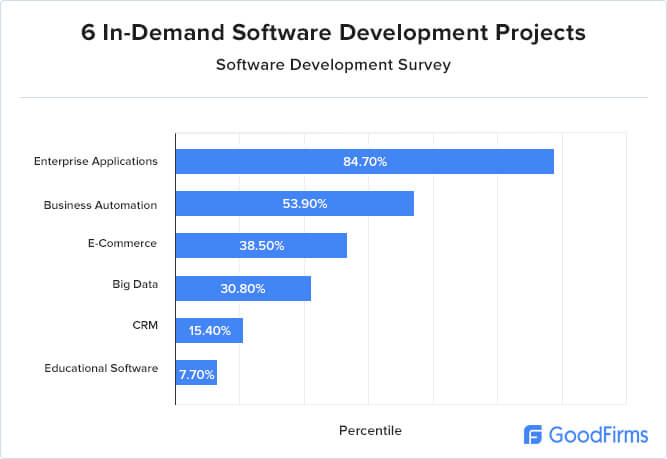
- With 84.70%, a large majority of the surveyed companies in the software industry develop Enterprise Applications for clients. This includes a wide range of software tools fulfilling a dozen corporate needs, from personal tasking and team management to project management and IT services management.
- Considering the craze for these proven tools, 53.90% of the participant agencies receive software projects for business process automation. According to developers, clients ask for software ranging from Stock Management Software to Computerized Maintenance Management Systems.
- Around 38.50% of developers produce back-end software and front-end web/app for E-Commerce owners. These include setting up an online store and developing supplementary software like inventory management, shipping, order management, etc.
- With every industry mogul going behind data, 30.80% of the software developers implied that they receive projects for Big Data and analysis.
- About 15.40% of agencies stated that they provide Customer Relationship Management software in various designs, such as chatbots, marketing automation tools, content management systems, etc.
- Digitization comes naturally to the education sector; around 7.70% of users help their clients build, manage, and maintain educational software.
9. Current Software Development Trends:
Software development is a tech-driven industry that has always been at the center of technology trends. Originally built for computer programming, it quickly adapted to website development for dot-com companies and mobile app development with the advent of smartphones and gadgets. With new technologies on the way, the software industry is set to adapt once again.
When participant agencies were surveyed, the following software development trends were jotted down:

- The industry's majority, about 69.20%, recognized that their client software demands are AI-powered. The majority of artificial intelligence developers develop business automation tools, chatbots, smart assistants, and machine learning techniques.
- Around 56% of the service providers concurred with the promising future of Blockchain Technology. Promoters of top blockchain development companies have demonstrated prototypes for future socio-economic institutions, which would include a more transparent system and smoother functioning.
- Yet another 47% of industry chiefs stake their focus on the Internet of Things. Assimilating the day-to-day life of humans, gadgets are being embodied to become smart assistants, which keep IoT app development companies on edge to upgrade and enhance user experience.
- The Runners-up include Big Data (31%), Cloud Computing (28.70%), AR/VR (26.50%), and Cyber Security (24%), among several others.
10. How will AI impact Software Development?
Artificial Intelligence has a great role to play for the software industry, according to three out of four surveyed experts. But how? A billion-dollar question, when asked to industry experts, garnered mixed replies. Breaking down experts’ vision for the sector, AI would be having an impact on largely two fronts: External & Internal, as they have put in various semantic arrays. Externally, the efforts would be to make AI-powered software focusing more on applicability. Internally, the tedious coding efforts would be eased with the help of AI-assistance, which focuses on utility. Encompassing all the views, here are the two ways Software Development is going to change -
AI Software:
AI-powered software is hot on the market. With an increasing need for automation, artificial intelligence provides a far more reliable solution. With innovative applications and blooming ideas, artificial intelligence developers offer a range of research for the software industry to cater to a greater good service.
Business Intelligence assists businesses in decision-making, while Business Process Automation enables self-executing business processes. Overall, it enhances customer experience with quality and quantity. Developers use AI to provide better functionality and create more responsive applications for users. A range of artificial intelligence software is available in the market that offers a state-of-the-art machine learning facility for everyone to aid their efforts.
Such demands would have a market-oriented impact on software development. Flexible development approaches, versatile and adaptive programming languages, apt development tools, and highly skilled resources would raise the basis of development.
AI making Software:
AI is revolutionizing all industry functions, and Software Development has not remained untouched either. With AI-assisted software development, developers' roles and skill requirements would change, giving them greater empowerment over processes and products.
One of the most gasping roles of AI is problem-solving. Traditional software development consumes great time and resources employed at figuring out problems, and then shrewd algorithms. With machine learning, one just needs to identify a set of cases and enter a collected range of data to the automation modules. Such modules could swiftly reckon important criteria and attributes of software, with dependencies much valuable than even humans.
Deep learning techniques would not only quicken the development methodologies but also assist developers at several stages of development and testing. Smart programming assistants are aimed at helping developers with real-time software coding and planning - equipped with a range of functions from to-do listing to code troubleshooting. While automated testing software would ease the difficulty of undetermined ecosystems to spot and rectify bugs and other issues.
Also, many firms dreaded that the advent of self-writing software would be catastrophic for the industry. While visionary firms see it as an opportunity to automate supplementary and tedious software prerequisites so that developers can focus on innovation and utility on the application front.
What to Take Away From These Statistics and Trends?
Custom software remains popular among businesses with large operations, providing flexible, integrated, and adaptive solutions. While a typical software development costs time and resources, it pays off in the long run with a smooth and evolving business undertaking. Also, most companies provide support and upgrades at a much lower price for a very long time.
An appropriate method commands the intricate tasks of software development, ensuring timely, cost-effective, and overwhelming software delivery. Playing with felicitous programming techniques and tools directly affects the quality of the software.
Given the greater-good impact AI is bringing to the software development industry, it is exciting to see what the industry will evolve to, which is sure to.
One of the main aims of the above research was to provide service seekers with key industrial factors for their software development projects. Setting several occupational standards for the IT sector, GoodFirms is here to assist you with a list of Top Software Development Companies that maintain high working standards with proven portfolios.
About Software Development Survey
We surveyed 150+ software development companies and industry experts to scrutinize the industry essentials, identify the latest trends, and produce market insights. Our activity was primarily aimed at agencies and freelance developers to harness the knowledge of the best practices in the market. At the same time, aiding seekers of software development services with industrial factors to consider when researching a wise partner.
The survey is furnished with experiences and prospects from participant companies whose expertise in developing software draws leads for tech trends. These companies, hailing from countries like the US, UK, Canada, Australia, Belarus, India, Ukraine, and Russia, added socio-economic versatility to the survey.
Here are the Research Partners who were adequately liberal and specific in sharing their knowledge in this comprehensive survey.



